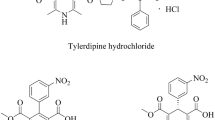Summary
Ketanserin is a serotonin S2-receptor antagonist that is an effective antihypertensive agent with a greater blood pressure reduction in older patients. We have reviewed the data from two studies of ketanserin pharmacokinetics in elderly patients, one in general practice (GP) and one in hospital patients. We compared these data with the results from two of our previous studies in young volunteers. The purpose was to determine whether the enhanced efficacy of ketanserin in elderly hypertensive patients could be due to altered pharmacokinetics. After a single dose of ketanserin, elderly hypertensives showed about a 60% increase in bioavailability compared with young volunteers. This increase is likely to be explained by a reduced metabolism of ketanserin on first pass through the liver. The elimination half-life of ketanserin was found to be longer in elderly hospital outpatients, but not in our elderly subjects in general practice. This prolongation of the elimination half-life of ketanserin appears to be unrelated to age, since the hospital outpatient elderly and elderly subjects in general practice were of similar ages. The elimination half-life of ketanserinol was longer in the hospital elderly subjects. This probably reflects a slight diminution of renal function in the elderly hospital outpatients, resulting in reduced clearance of ketaserinol. The peak and trough ketanserin concentrations were similar in young and elderly subjects during chronic treatment, and it is therefore unlikely that the increased efficacy of ketanserin in elderly patients is due to altered pharmacokinetcs.
Similar content being viewed by others
References
Cameron HA, Ramsay LER. Ketanserin in essential hypertension: A double blind placebo controlled study. Postgrad Med J 1985;61:583–586.
Korlipara K, Gould SE, Taylor NA, et al. Comparative trial of ketanserin of bendrofluazide as add-on therapy in hypertensive patients uncontrolled on a β-blocker alone. Drugs 1983;36(Suppl 1):130–134.
Rodendorff C, Murray GD. Ketanserin versus metoprolol and hydrochlorothiazide in essential hypertension: Only ketanserin's hypstansive effect is age related. J Hypertens 1986;4(Suppl 6):S109-S111.
Meuldermans W, Hendrickx J, Woestenborghs R, et al. Absorption, metabolism and excretion of ketanserin in man after oral administration. Arzneim-Forsch (Drug Research) 1988;38:789–794.
Frenken M, Kaumann AJ. Interaction of ketanserin and its metabolite ketanserinol with 5HT2 receptors in pulmonary and coronary arteries of calf. Naumyn-Schmiedeberg's Arch Pharmacol 1984;326:334–339.
Van Peer A, Woestenborghs R, Embrechts L, et al. Pharmacokinetic approach to equilibrium between ketanserin and ketanserin-ol. Eur J Clin Pharmacol 1986;31:339–342.
Ramsay LE, Tucker GT. Drugs and the elderly. Br Med J 1981;282:125–127.
Greenblatt DJ, Sellers FM, Shader RI. Drug disposition in old age. N Eng J Med 1985;306(18):1081–1088.
Heykants J, Van Peer A, Woestenborghs R, et al. Pharmacokinetics of ketanserin and its metabolite ketanserinol in man after intravenous, intramuscular and oral administration. Eur J Clin Pharmacol 1986;31:343–350.
McGourty JC, Silas JH, Cowen KJ. Controlled trial of ketanserin in hypertension. Br J Clin Pharmacol 1985;20:37–40.
Okonkwo PO, Reimman IW, Woestenborghs R, et al. High performance liquid chromatographic assay, with fluorometric detection of ketanserin, a new antihypertensive agent and serotonin S2-antagonist in human plasma, blood and urine. J Chromatogr 1983;272:411–416.
Kurowski M. Bioavailability and pharmacokinetics of ketanserin in elderly subjects. Eur J Clin Pharmacol 1985;28:411–417.
Barendregt JNM, Van Peer A, Van Oene JC, et al. Pharmacokinetics of ketanserin in patients with renal insufficiency. Data presented at 3rd Int Symposium on Hypertension in the Community, Tel Aviv, Israel, December 1988.
Donnelly R, Elliott HL, Meredith PA, et al. Ketanserin in essential hypertension-individual response and concentration effect relationship. Br J Clin Pharmacol 1988;25(1):103P.
Author information
Authors and Affiliations
Rights and permissions
About this article
Cite this article
Gould, S.E., Silas, J.H. & Hosie, J. Could the increased antihypertensive efficacy of ketanserin in the elderly be due to altered pharmacokinetics?. Cardiovasc Drug Ther 4, 89–92 (1990). https://doi.org/10.1007/BF00053435
Issue Date:
DOI: https://doi.org/10.1007/BF00053435




